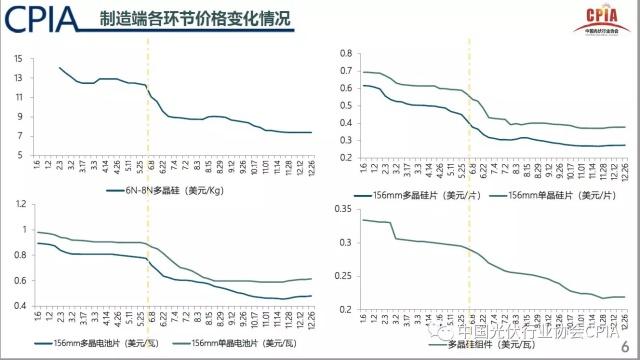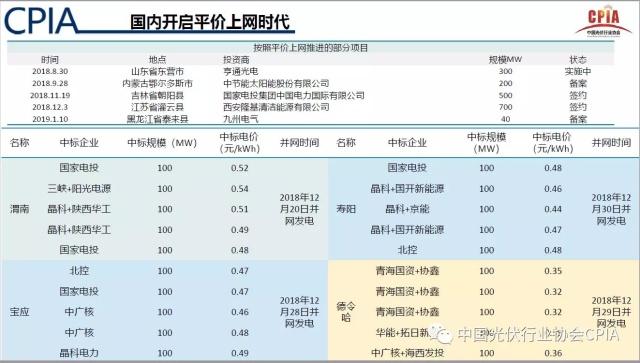After the most stringent "531 Weaning New Deal" in history in 2018, is the Chinese PV industry dying in the dark or accelerating the spring of cheaper Internet access? The "Photovoltaic Industry 2018 Development Review and 2019 Situation Outlook Seminar", hosted by the China Photovoltaic Industry Association and held in Beijing on January 17, provides a panoramic view of the current status of China's PV industry. China's PV industry is gradually shifting from subsidy dependence to parity, from extensive development to refined development, and industry consolidation in the post-subsidy era continues.
Wang Bohua, vice chairman and secretary general of China Photovoltaic Industry Association, said at the seminar that “531 PV New Deal†caused the PV industry to experience the biggest policy environment change since 2013. However, after the promulgation of the New Deal, the domestic market still maintained a high installed capacity. The annual installed capacity of photovoltaics exceeded 43GW (1GW=1000MW, 1MW=1000KW) and continued to rank first in the world. From the perspective of all aspects of the manufacturing end, the performance in 2018 is lower than expected at the beginning of the year, but higher than the pessimistic judgment made in the downturn of the industry after the New Deal was promulgated. In terms of capacity utilization rate, enterprises with different production scales are obviously differentiated. The first-line enterprises with higher annual production capacity have an average operating rate of about 70% due to scale advantages and developed overseas markets. The operating rate of enterprises is seriously insufficient, less than 50%. In addition, 2018 is the most active year for Chinese PV companies in technological innovation. The export of PV products continues to grow, and the light rejection rate continues to drop to 3%.
In 2018, the domestic PV industry continued to grow, and exports reached the highest level after the “double opposition†in Europe and America.
The continued expansion of the renewable energy subsidy gap is one of the main reasons for the authorities to seek industrial policy shifts. According to statistics, as of the end of 2017, the renewable energy subsidy gap has reached 100 billion yuan.
On June 1, 2018, the National Development and Reform Commission, the Ministry of Finance and the National Energy Administration announced the new policy of more than a thousand words of photovoltaic power generation, which triggered a huge earthquake in the whole industry as much as a few years ago. The new policy document was filed on May 31st, so it was called "531 Photovoltaic New Deal" by the industry. Although the energy authorities had released the policy tightening signal earlier this year, the “limited size, power cuts, and subsidies†have been adopted in a multi-pronged manner, and the new policy marked by “strong acceptance†has been severe and unbuffered. Far beyond the industry expectations. The subsequent decline in the operating rate of production companies, the start-up of pay cuts and the fall in the price of photovoltaic products by some companies have caused the Chinese PV industry to be overshadowed by the growing pessimism.
From the perspective of the whole year, the photovoltaic industry continued to maintain steady growth in 2018. According to the statistics of China Photovoltaic Industry Association, the output of all links in the manufacturing sector last year maintained different degrees of year-on-year growth: in 2018, polysilicon production exceeded 250,000 tons, an increase of over 3.3% year-on-year; wafer production was 109.2GW, up 19.1% year-on-year; The output of the battery was 87.2GW, an increase of about 21.1% year-on-year; the output of the module was about 85.7GW, a year-on-year increase of 14.3%.
At the same time, the amount of photovoltaic power generation continues to rise, and the rate of light rejection continues to decline. In 2015-2018, the amount of photovoltaic power generation increased from 40 billion kWh to 170 billion kWh, and the light rejection rate dropped from double digits to 3%.

In the case of continued decline in product prices, driven by the continued growth of the global PV market and the gradual release of overseas base capacity, domestic PV product exports continued to grow last year. In 2018, the total export value of photovoltaic products (silicon wafers, cell sheets, modules) reached US$16.11 billion, reaching the highest level after “double-reverseâ€, up 10.9% year-on-year; silicon wafers and battery sheets were affected by price declines, and export prices decreased; components Exports and exports doubled; exports in all segments exceeded 2017, with component exports up 30% to 41GW.

With the European Union’s five-year “double opposition†to China, the European Union’s market has recovered, China’s anti-dumping and countervailing measures against PV products in China announced in August 2018, after the expiration of September 3, 2003. Last year, exports to major European countries (the Netherlands, Germany, and the United Kingdom) increased year-on-year, and exports to Ukraine and Spain increased significantly.
In order to avoid trade protection risks, according to industry association statistics, more than 20 PV companies in China have set up production capacity overseas through joint ventures, mergers and acquisitions, investment, etc., mainly in Vietnam, Thailand, Malaysia and other countries. Enhanced. Under the influence of the “531 New Dealâ€, domestic enterprises have expanded their power station development, EPC, operation services and energy storage businesses overseas, and the industry is on the rise of a new round of “going outâ€.
Industry consolidation will continue, and the gap in renewable energy subsidies remains “pressurefulâ€
In 2019, the industry reshuffle will continue. Photovoltaic companies are getting together with IPOs or backdoors. Once successful, the funds raised will drive continued capacity expansion and industry consolidation. Industry associations believe that in the field of polysilicon, new capacity will continue to be released in 2019, and silicon materials in the central and eastern regions will be phased out due to cost reasons. The industrial layout will be further concentrated in the western region; silicon wafer links, Longji, Zhonghuan, GCL, and Jingke The pattern of the Big Four is emerging, and with the increasing capacity of high-efficiency batteries, the downstream requirements for the quality of silicon wafers are increasing, increasing the barriers to entry of monocrystalline silicon wafers; the battery segment, Tongwei, Longji, Aixu, Zhanyu and others have sprung up, ranking the top of battery capacity production, and the battery capacity in Taiwan has gradually come to a close; component parts, due to on-demand production, flexible construction, there is no need for continuous production, so there will be no major integration, large Enterprises continue to maintain competitive advantage due to the threshold of brands and channels, and the survival pressure of medium-sized enterprises will increase. Small enterprises still have a certain living space because they can obtain orders for large enterprises.
After a series of reshuffles and adjustments, the risks and challenges of the Chinese PV industry remain. The growing gap in renewable energy subsidies is still a big mountain at the top of the head. Wang Bohua said that the gap in 2018 is expected to exceed 140 billion yuan, of which the photovoltaic gap is over 60 billion yuan. The amount of subsidies for enterprises with large holdings of power plants has reached several billion yuan, and is increasing at a rate of several hundred million yuan per month, which has been under tremendous financial pressure.
“The paradox is that the sustainable development of the industry and the active advancement of the energy revolution need to maintain a certain market size. The gap in subsidies on the one hand has caused the power station developers to squat, and on the other hand has bound the industry authorities to set the annual installed scale. It has affected the progress of policies such as price and scale in the next few years." Wang Bohua said.
In addition, the current PV production capacity has a growing, staged excess tendency, which requires industry consolidation to achieve sustainable development. However, under the complicated internal and external situations, stable growth and stability pressures have brought greater pressure on the industry integration and affected the timely exit of backward production capacity. There are also inconsistencies and controversies between the number of industry standards and the difficulty of practice.
Wu Shengwu, deputy director of the Department of Electronics and Information Technology of the Ministry of Industry and Information Technology, pointed out at the seminar that in 2018, the domestic photovoltaic industry has a phased capacity, structural imbalance between supply and demand, a single product structure, small corporate differences, and a lag in the standard testing and certification system. No adjustment is needed. The photovoltaic industry and enterprise development are facing many challenges. In China, faced with strong pressures such as structural adjustment, reshaping of industrial structure, and acceleration of innovation in technology and business models, corporate decisions are slightly inadvertent and there is a risk of being eliminated. In foreign countries, the trading environment is becoming more complex, and some countries or regions Accelerating the scale development of photovoltaic manufacturing industry also brings certain competitive pressure to the industry.
Shower Water Tap Valve And Pipe
Hand Shower,Plastic Faucet,Top-Spout,Brass Ball Valve
SHAOXING SINO IMPORT & EXPORT CO.,LTD , https://www.sxsmarto.com
